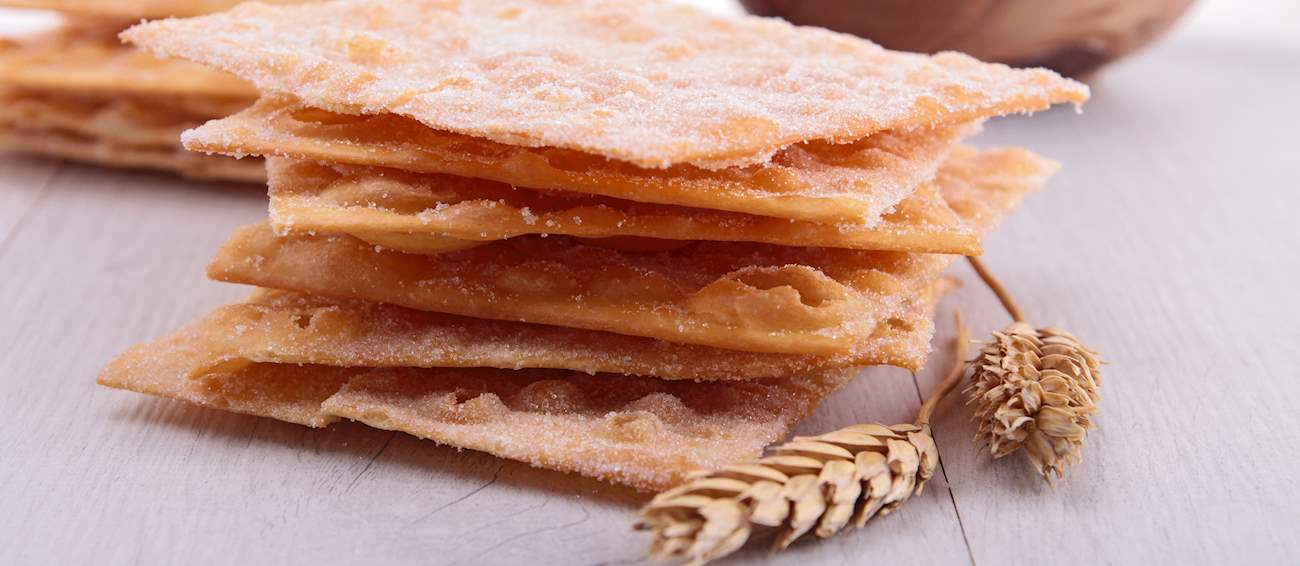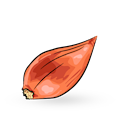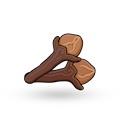MAIN INGREDIENTS
Pâté Lorrain is a French dish consisting of marinated meat that is wrapped in puff pastry. In traditional French cuisine, the meat needs to be a mixture of pork and veal, although modern recipes also suggest other varieties, such as rabbit or chicken.
The meat is sliced and marinated in a flavorful mixture of wine, thyme, parsley, bay leaves, and shallots. Before baking, it is completely enclosed in puff pastry. The dish is usually associated with Baccarat, a commune located in the Lorrain region.
MAIN INGREDIENTS
Hailing from Provence, oreillettes are the thin, rectangular sheets of deep-fried dough. They are prepared with flour, eggs, and butter, and are usually enriched with citrus zest and orange flower water. Traditionally enjoyed during the Carnival season, they are best served freshly prepared and generously coated in powdered sugar.
These crispy fritters are also enjoyed in the neighboring Occitanie region.
MAIN INGREDIENTS
Palmiers are a delectable snacks made from puff pastry that are sprinkled with sugar, rolled, and then cut into slices. Due to its shape, palmiers have been given a variety of nicknames; pig's ears, elephant ears, glasses, and palm leaves to name a few.
These simple pastries are often paired with coffee or tea, and can be further enriched with the addition of sweet or savory spices and fillings.
MAIN INGREDIENTS
Pain aux raisins or escargot (lit. snail) is a French spiral-shaped pastry made with a combination of leavened buttery dough or sweetened bread dough, raisins, and crème pâtissière. Once filled, this sweet treat is baked until its edges become slightly golden.
Pain aux raisins is traditionally served in the morning for breakfast, although it is also sometimes enjoyed throughout the day with café latte or black coffee.
MAIN INGREDIENTS
Tarte tropézienne is a French dessert consisting of a brioche pastry, usually orange flavored, which is cut in half and filled with a creamy filling. Since the original recipe is a secret, fillings may vary, including pastry cream, buttercream, crème diplomat, or other pastry cream varieties.
The top is usually decorated with sliced almonds, pearl sugar, or a thin layer of powdered sugar. The recipe for this cream-filled brioche has arrived in France with the Polish pastry chef named Alexandre Micka in 1950. In 1955, during the filming of a famous movie in Saint-Tropez, Micka was supplying the entire crew with his food, and when he offered his brioche invention to the renowned actress Brigitte Bardot, she named the dessert pie de Saint-Tropez.
Canelé is a little cake with a rich, custardy interior, and a thin, caramelized exterior, invented by an anonymous cook from Bordeaux in France. There is a theory that the dessert originated in the convent of the Annunciation in Bordeaux, specializing in the production of candied nuts and sweet sticks known as canelets.
Canelets were traditionally made by the nuns and given to the poor. In 1790, the nuns left their convent, but the recipe was rediscovered and improved by Bordeaux cooks in 1830. Today, canelé is an emblematic symbol of the city of Bordeaux, kept as the city's specialty, but it can also be found in numerous Parisian pâtisseries.
Chaussons aux pommes are traditional French turnovers filled with a delectable apple compote filling. The turnovers are made with a combination of peeled and cored apples, flour, sugar, cinnamon, puff pastry, and beaten eggs. The apples are chopped, combined with flour, sugar, cinnamon, and water, then mixed.
The filling is placed in the center of the puff pastry circle, which is then folded into a semicircle and brushed with egg wash so that it sticks. The top is also brushed with eggwash, and the pastry is baked until it puffs up and becomes golden brown.
MAIN INGREDIENTS
A true show-stopping centerpiece, croquembouche consists of choux pastry profiteroles which are filled with custard cream and assembled into a cone-shaped tower, glued together with caramel. The final dessert is elaborately decorated with spun sugar, sugar-coated almonds, fondant flowers, fruit, or even macarons.
Croquembouche was designed and popularized in the late 1700s by chef Antonin Carême, while its name is derived from the expression croque-en-bouche, which literally translates to crunch in the mouth, referring to the crunchy and caramelized bits and pieces.
TasteAtlas food rankings are based on the ratings of the TasteAtlas audience, with a series of mechanisms that recognize real users and that ignore bot, nationalist or local patriotic ratings, and give additional value to the ratings of users that the system recognizes as knowledgeable. For the “8 Worst Rated French Pastries” list until April 19, 2025, 5,984 ratings were recorded, of which 5,295 were recognized by the system as legitimate. TasteAtlas Rankings should not be seen as the final global conclusion about food. Their purpose is to promote excellent local foods, instill pride in traditional dishes, and arouse curiosity about dishes you haven’t tried.













